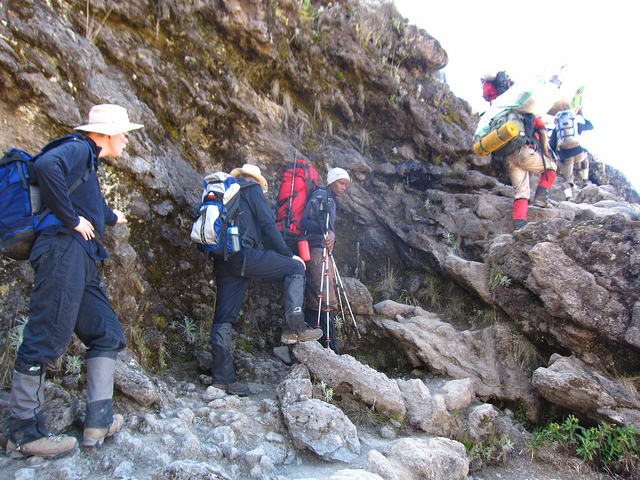How to Avoid Kilimanjaro Altitude Sickness
Kilimanjaro Altitude Sickness sometimes referred as acute mountain sickness (AMS) is a common illness that affects a significant proportion of people that ascend to high altitude. The symptoms are headache and fatigue, sleep disturbance, problems with the digestive system and dizziness.
Mount Kilimanjaro is an extremely popular climb among inexperienced climbers. As a result of expensive park fees and the abundance of alternative tourist attractions nearby, the rushed round trip to the 5895m summit is often attempted in as little as 5 days. It is therefore perhaps not surprising that many of the climbers attempting the summit suffer altitude sickness.
For the majority of sufferers AMS remains no more than an inconvenience. However, for a significant minority AMS can develop into one of two potentially fatal conditions: High Altitude Pulmonary Edema (HAPE) or High Altitude Cerebral Edema (HACE).
These conditions both require immediate attention that’s why you need Acclimatization To avoid Altitude Sickness on Kilimanjaro.
How To Avoid Kilimanjaro Altitude Sickness – Overview.
Acclimatization To avoid Altitude Sickness on Kilimanjaro are the only thing that has been proven to protect against AMS on Kilimanjaro. Climbers looking for the best chance of avoiding altitude sickness can acclimatize during trekking which gives you the best chance of success on the summit attempt of Mount Kilimanjaro. In addition, the ascent of Mount Kilimanjaro is so rapid that climbers should not assume that acetazolamide (Diamox) can protect them from developing Acute Mountain Sickness.
Acclimatization on Kilimanjaro.
Acclimatization is the process by which the body becomes accustomed to lower availability of oxygen in the air and can only be achieved by spending time at various levels of altitude before progressing higher.
Oxygen, Air Density and Altitude.
Acclimatization is best understood by looking at the relationship between oxygen in the air, air density and altitude changes.
At sea level oxygen accounts for about 21% of air and barometric pressure is around 760 mmHg. As one climbs in altitude the amount of oxygen in the air remains about the same (up to approximately 21,000 meters or 69,000 feet), however, air density drops and thus less pressure is put on packing oxygen molecules closer together (imagine oxygen molecules moving further and further away as altitude increases).
For example, at about 3,600 meters (12,000 feet), barometric pressure is around 480 mmHg. With less air density, oxygen molecules are more widely dispersed in any given column of air and hence less oxygen is available per breath.
Blood oxygen saturation.
The body deals with this decrease in available oxygen by breathing faster and deeper (even at rest) so as to increase the oxygen content in the blood.
The chart below shows the typical profile of oxygen saturation in an average person’s blood as one ascends to higher altitudes. For the average person, you can see that blood oxygen saturation (SO2) decreases to nearly 80% at 6,000m (just above Kilimanjaro’s summit).
What to do to Acclimatize and prevent altitude sickness On Kilimanjaro
Walk Slowly (pole pole)
When you climb Kilimanjaro, you will hear the phrase ‘Pole, pole’. This means ‘slowly, slowly’ in Swahili. The best way for your body to adapt to altitude is to move really slowly. This allows the intelligent body to adapt to the effects of altitude on Kilimanjaro. The higher you climb the higher the altitude and the harder it takes your body to cope up with its environment.
Hydration
Drinking a lot helps and its renown to be one of the BEST method while dealing with acclimatization. We recommend at least drinking 4-5 Liters of water a day while climbing Kilimanjaro. It is usually good to keep an eye on your urine; if it gets too dark, you need to drink more.
Climb high sleep low
Another practice is “Climb high; sleep low.” What this means is that you should do day hikes that gain significant altitude, s and then return to sleep and recuperate at lower altitudes.
Avoid tobacco and alcohol and other depressant drugs including, barbiturates, tranquilizers, and sleeping pills. These depressants further decrease the respiratory drive during sleep resulting in a worsening of the symptoms.
Eat nutritious rich food
Eat a high carbohydrate diet (more than 70% of your calories from carbohydrates) while at altitude.
Incase you notice altitude symptoms
If you begin to show symptoms of moderate altitude illness, don’t go higher until symptoms decrease .( in fact you should go to a lower elevation until you feel better)
Use our Booking form below to get a details of Kilimanjaro fitness & packages .

